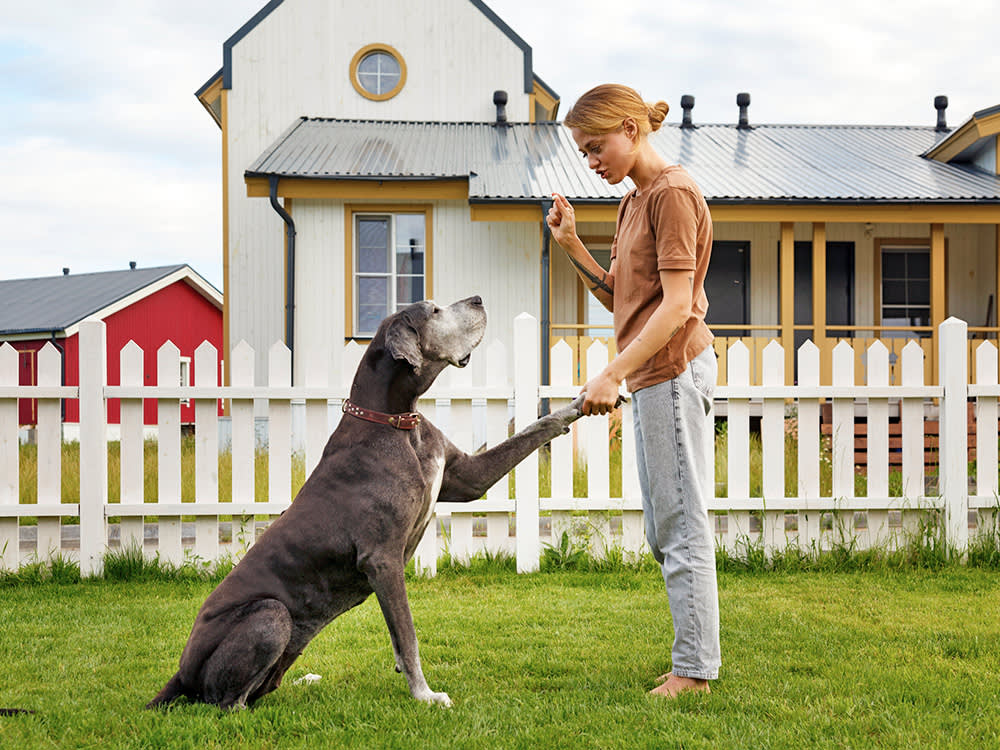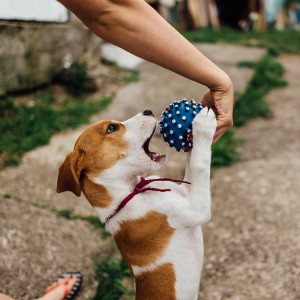7 Dog-Training Myths—Busted by a Behaviorist
Training them to roll over is useless—and other falsehoods.

Share Article
Dog training is a field that has so-called experts everywhere you look. But if you are getting training advice from people without education and experience in dog training, you may be hearing more fiction than fact. Top-notch dog trainers typically have formal education about the process, have been training for many years, and are certified through one or more professional organizations.
Just as trainers should not give medical or grooming advice, groomers, rescue workers, veterinarians, etc. should not give training advice unless they also have true expertise in the area. It’s best to listen to dog-training professionals to learn the real scoop, rather than be led astray by the many common myths about dog training.

littleKin™ is Kinship’s home just for puppy and kitten parents. Bop over to check out expert advice, new pet tools, and special deals—all curated for your newest family member.
opens in a new tabHere are some not-so-true statements I hear all the time that I’d like to set straight.
1. Dogs who don’t respond to a cue are being stubborn.
There’s a tendency to assume that if a dog doesn’t do what they’ve been asked to do, it’s because they are stubborn, and that’s not fair. There are so many reasons dogs don’t respond to cues, and one of the first ones is that they have not been trained to respond to them in a variety of contexts. Maybe they can come when called at home, where nothing is distracting them. But if they don’t come running at the sound of their nameopens in a new tab at the park, that doesn’t mean they are obstinate. It might just mean that environment is too distracting for them.
If they sit sometimes but not all the time, maybe it hurts them to sit because they have joint painopens in a new tab. In that case, they are more likely to do it in the morning than at night after their body has been through too much.
2. Using food in training is bribery.
If it’s done right, using food to train is a form of positive reinforcementopens in a new tab. After the dog performs the behavior you are training them to do, you give them a treatopens in a new tab, which means you are reinforcing that behavior. You are using positive reinforcement to increase the likelihood of them doing that skill again.
If you show a dog a treat and then ask them to do something, that is bribery, and you will end up with a dog who only performs the behavior you request if they see the goods up front. That approach doesn’t work well for training, to say the least. So, the technique and timing of using food can be a problem, but the food itself is not.
3. You should wait until your dog is fully vaccinated to begin training.
It’s true that puppies who have not been fully vaccinated need to be protected from exposure to serious diseases. That means no dog parksopens in a new tab, no boarding kennels, and following advice from your veterinarian about other high-risk situations. It does not mean they shouldn’t begin training. Training in puppy classesopens in a new tab with other puppies who have at least started their vaccinations is relatively safe. Plus, the advantages of socialization, bonding, and training are worthwhile for healthy puppies.
In addition, so much training can be done at home, on walks, during visits to the veterinarian, in the backyard, and anywhere else you go with your puppy.
4. Positive reinforcement only works for easy cases and easy dogs.
Positive reinforcement is incredibly powerfulopens in a new tab. There is a strange idea in the world of dogs that gentle, kind, positive treatment of others may be nice, but it is not as effective as being harsh, nagging, whining, or even using physical force. I stand by the idea that force is the absence of real power, and that reward-based training is powerful enough for all kinds of behavior goals.
I believe that when people don’t see that positive reinforcement can be used to train dogs, even in tough casesopens in a new tab, they likely don’t know enough about the training method or have the skills to use it effectively in the real world.
5. Training your dog to do tricks is fun but is otherwise useless.
Trick-training has advantages far beyond having a dog who can show off some impressive skills. The training is fun and often not a high-pressure activity. People often get stressed and upset if their dog doesn’t come when called or hold their stay. If a dog doesn’t quite nail a skill like wave or roll overopens in a new tab, pet parents have a tendency to shrug and say, “Oh, well!” Trick-training is often really fun and not fraught with expectations the same way some other training is. The interaction is typically happy, which is good for your relationship with your dog.
Dogs get to be right and have all the benefits of positive reinforcement, like treats, praise, and play, without any disappointment from people. The mental exercise is good for them, tiring out their brains and preventing boredom. In addition, many tricks can be really practical. For example, when I lived on a farm, I often had my dog crawl through snow before coming inside so he brought less mud inside.
I teach dogs to present their paws as a shake opens in a new tabto make it easier to draw blood at the vet and teach them to go belly-up to make exams easier. (I use the cue “smoke” so I can say to a dog, “What happens when you smoke?” When they hear this, they lie on their back with their legs in the air.)
6. Dog training needs to be done in formal sessions.
There’s nothing wrong with training in formal sessions, and I love dog-training classes as well as working on skills at home in designated periods. Your dog is always learning, whether you mean to be teaching them at that moment or not. That can work against you if you, say, accidentally teach your dog that you will pet them and give them attention when they jump up on you.
However, it can also be used to your advantage. For example, if your dog comes running whenever they hear you open a treat bag, you can call, “Come!” right before you rattle the bag so your dog learns that good things happen around you when they hear that cue.
Some of the best training occurs as life happens and in very short sessions, not in a formal session with separate time set aside. So, you can ask your dog to wait before letting them out of the crateopens in a new tab, ask them to sit before you put on their leash prior to a walk, or give them a cue to lie down before feeding them. Here’s an excellent training practice: Grab a handful of treats, and for 10 to 30 seconds, work on teaching your dog to do something you want them to do. Or you can ask them to do what they already know and them a treat every time they wave, sit, shake, spin, etc.
7. All you need is an understanding of training methods.
Training dogs effectively requires more than just an understanding of specific approaches — you need more. The best training is possible when there is a good relationship between the trainer and the dog. And to achieve that, it’s essential to have the following:
good observation skills
a training plan so you know how to advance through the process
an ability to read dog body language
good timing
high-quality reinforcement
a situation in which the dog can concentrate enough to succeed
knowledge based on experience of when to stop a training session
flexibility
The takeaway: Find these training truths for yourself.
Training our dogs is easier and more effective when we know the truth and aren’t being led astray by any pesky myths. When it comes to learning about dog training, rely on information from the actual experts: dog trainers. Their expertise is the real treat!

Karen B. London, PhD, CAAB, CPDT-KA
Karen B. London, Ph.D., is a Certified Applied Animal Behaviorist and Certified Professional Dog Trainer who specializes in working with dogs with serious behavioral issues, including aggression, and has also trained other animals including cats, birds, snakes, and insects. She writes the animal column for the Arizona Daily Sun and is an Adjunct Professor in the Department of Biological Sciences at Northern Arizona University. She is the author of six books about training and behavior, including her most recent, Treat Everyone Like a Dog: How a Dog Trainer’s World View Can Improve Your Lifeopens in a new tab.
Related articles
![Young blonde woman with a Jack Russell puppy during spring in the city.]() opens in a new tab
opens in a new tabThe Best Training Treats for Dogs in 2025
The most mouth-watering treats for training your pup.
![A dog walking in the grass alongside a dog trainer.]() opens in a new tab
opens in a new tabHow to Become a Dog Trainer
This guide will help you turn your dog training passion into a profession.
![Juliana DeWillems, KPA CTP, is a member of the Karen Pryor Academy faculty.]() opens in a new tab
opens in a new tab10 Dog-Training Instagram Accounts You’ll Love as Much as Dogs Love Squirrels
The answer to your obedience questions—right there on your phone.
![A dog reaching up to grab a blue ball out of a woman's hand.]() opens in a new tab
opens in a new tabPlaying With Dogs Improves Their Training Success
Post-training play may extend a dog’s memory of previously learned behaviors by up to a year.
![Adorable puppy focused on learning commands at home in living room]() opens in a new tab
opens in a new tabDog Training 101: What to Teach Your New Dog
In between cuddle sessions, work on these eight basic cues with your pup.






